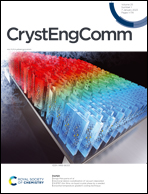Designing of a Zn(ii)-isonicotinohydrazido thiophenyl based 2D coordination polymer: structure, augmented photoconductivity and superior biological activity†
Abstract
Thiophenyl-isonicotinohydrazide, a multidentate Schiff base, acts as a tridentate N,O,N donor out of which N,O-chelates to one Zn(II) and pyridyl-N links to the adjacent Zn(II) to constitute a 2D coordination polymer, {[Zn(SIZ)2]·DMF}n (CP1) (HSIZ = (E)-N′-(thiophen-2-ylmethylene)isonicotinohydrazide, DMF = N,N-dimethylformamide). CP1 has been characterized by different physicochemical data and confirmed by single crystal X-ray crystallographic measurement. The H-bonding, C–H⋯π and π⋯π interactions in the 2D geometry of the coordination polymer creates a 3D architecture. The Tauc plot for CP1 indicates an optical band gap of 2.91 eV (calc., 2.48 eV) (direct)/2.80 eV (calc., 2.50 eV) (indirect) and CP1 is non-conducting (2.53 × 10−9 Sm−1) in the dark while it is enhanced by ∼23 000 times (5.97 × 10−5 Sm−1) upon light irradiation (1000 Wm−2). Considering the biological importance of isoniazid and Zn(II) the antimicrobial activities of CP1 is measured against Staphylococcus aureus and Escherichia coli (MIC, 20 μg mL−1). The cytotoxic potency of CP1 is examined on thirty different cancer cell lines which has been found active against four cancer cell lines, HCT-116 (colon cancer), HeLa (cervical cancer), MDA-MB-231 (human breast cancer cell), and HepG2 (hepatocellular carcinoma) and the results are compared with the human normal kidney epithelial cell line, NKE. However, CP1 shows the highest anticancer efficiency against HeLa (IC50: 9.13 ± 2.32 μg mL−1) cells. The mechanism of cell killing activity may presumably be the generation of intracellular reactive oxygen species as suggested by the caspase 3/7 activation assay.



 Please wait while we load your content...
Please wait while we load your content...